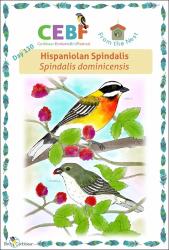| Abstract | Caribbean Endemic Bird Festival (CEBF) day 130 poster, dedicated to the Hispaniolan Spindalis. Males of this species are unmistakable. They sport a black head with two bold white stripes, one above the eye and another at the ‘malar’ or mustache region. They have a rich yellow nape and breast, fading to a gray belly. Their bright yellow contrasts with an olive back patch and crimson-chestnut breast spot, sometimes with a charcoal center. They have striking black wings and tail feathers, edged white with a rusty shoulder patch. Sometimes their mandarin orange rump feathers will peek through their primaries. Females don’t boast quite as bright of a suit. Instead they flaunt a subtle beauty, with an overall olive-brown coloration to their feathers and fine streaking on the breast. Their wings and tail feathers are edged a soft yellow, giving a slight glow about them. At first, they may be more difficult to recognize, but both males and females have a similar small, gray bill with a hook on the end. Both young males and older females can have an intermediate look. For such a colorful bird, the male Hispaniolan Spindalis isn’t much of a singer. They give a thin, high-pitched whistle “tsee” or a rapid “tsi-tsi-tsi-tsi-tsi.” Often they’ll whistle these high pitched notes from atop a tree or within a dense thicket. Females even have their own soft response, that sounds like a jumble of notes. The Hispaniolan Spindalis was formerly considered part of the Stripe-headed Tanager complex, which included Western Spindalis, Puerto Rican Spindalis, and Jamaican Spindalis. Recently, they were split up into the four species that we know today. And they were even given their own unique avian family, Spindalidae, separating them from other tropical tanagers and creating another endemic bird family for the Caribbean! Look for them in a variety of wooded habitats from sea level to 2,500 m in both the Dominican Republic and Haiti. Though they seem especially abundant in montane habitats in evergreen pine and broadleaf forests, they may wander down to lower elevation habitats during the non-breeding season usually in search of more fruits! They are primarily frugivores, feeding on a variety of tropical fruit, flowers, seeds, and leaf greens; though they may expand their palette to include insects during the breeding season. Usually they prefer to forage in small groups of 3-4 birds; though with an abundance of ripe fruit you’ll sometimes see more birds join the flock! Breeding season is usually May – June. Pairs will build a small cup nest out of dry grasses and place it about 1.5 m up in a tree or shrub. The female lays 3 whitish eggs with brownish spots. Her more camouflaged plumage helps with avoiding predators during incubation and feeding the chicks in the nest. Although the Hispaniolan Spindalis is still widespread and common throughout Hispaniola, it is likely starting to experience declines due to habitat loss. Protected areas, such as national parks and reserves on the island, have provided vital habitat for these stunning birds. It is important that we all do our part to learn about and protect these birds so that we can continue to enjoy them! As a complement to the poster, a coloring sheet is included. | es |



